Improving Employee Efficiency in the Workplace: 12 Effective Tips
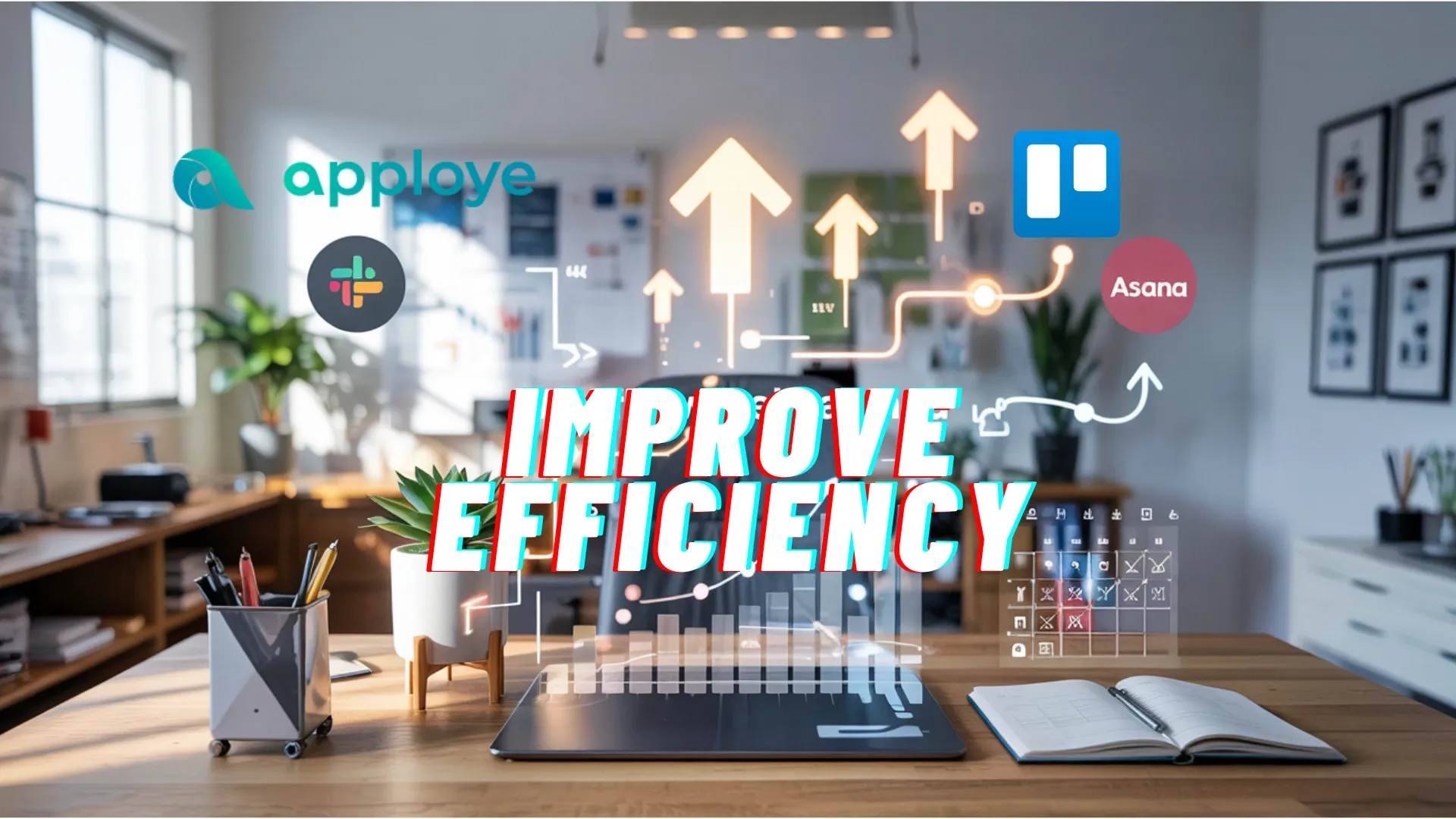
Summary:
-
Employee efficiency means completing tasks with speed, accuracy, and focus. It is possible with clear goals, less stress, and smarter workflows.
-
Strategies like time-blocking, automating tasks, reducing distractions, and setting clear priorities boost output.
-
Tools like Apploye, Slack, Asana, and Microsoft Teams help track time, manage tasks, and improve daily workflows.
Only 23%! That’s how much employees are engaged with work. And this low engagement costs the global economy 8.9 trillion!
So, how do we improve employee engagement and boost efficiency?
We’ve all seen the checklists: fewer meetings, better tools… but if it were that simple, every team would be efficient.
So, these actually don’t work, and here, we’ll learn proven ways to improve employee efficiency while keeping them happy in a healthy office environment!
In this article
- Strategies to improve employee efficiency
- Effective tools and techniques for remote and hybrid teams
- Quick ways to boost team output
- Creating a highly productive workplace
- Real-world example of efficiency improvements
12 Strategies to Improve Employee Efficiency at Work
Now you know that a team can look busy but not be productive. And thinking efficiency is just about one person is wrong. It's about how the whole team works together!
But how do you know if your office is efficient enough?
Efficient workplaces have these in common -
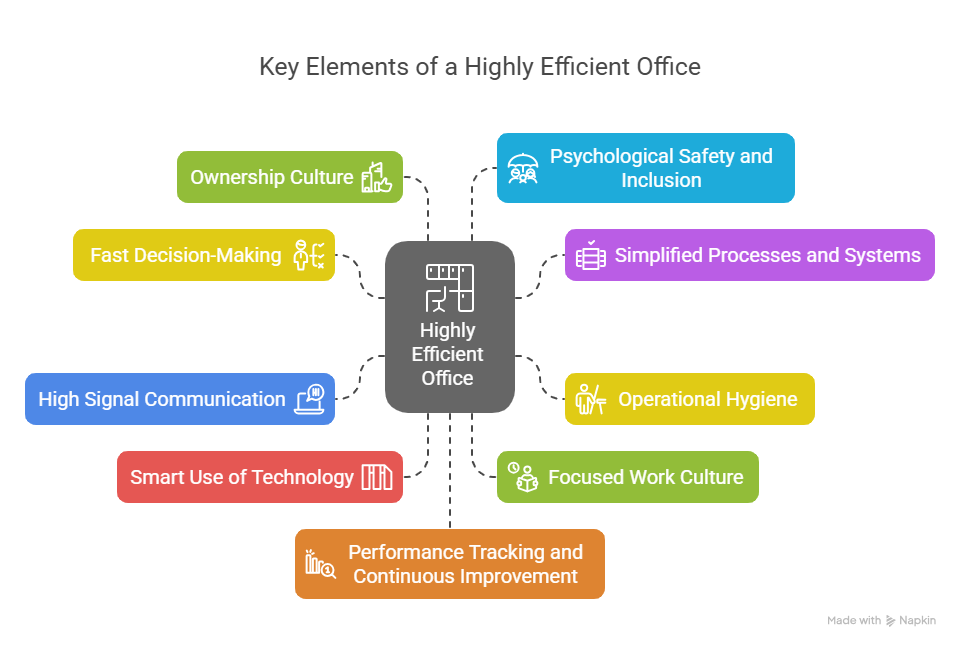
1. Fast Decision-Making
Imagine a workplace where decisions happen fast, not stuck in endless meetings. Everyone knows their job, and if something slows things down (like needing tons of approvals), it gets fixed right away!
Think of Amazon's two-pizza teams that avoid bottlenecks and make quick calls. These teams have just enough people to share two pizzas, usually around ten people or fewer. This way, they can make decisions quickly, try out new ideas faster, and really listen to what customers want.
When decisions are made faster, you don’t have to wait much. Less waiting means more work gets done!
2. Simplified Processes and Systems
Beyond quick decisions, a highly efficient workplace thrives on streamlined processes and systems! This means having well-documented workflows and Standard Operating Procedures (SOPs).
These systems let you automate routine tasks and minimise bureaucracy.
Organized systems reduce time wasted on figuring out how to do things. So employees can focus on more productive work!
3. Operational Hygiene
According to an IDC study, knowledge workers squander about 2.5 hours daily searching for information.
But imagine a digital workspace where you're not constantly searching for files. This is "operational hygiene."
You have clean dashboards, accurate productivity metrics, and tasks tracked in one place. This eliminates the dreaded "Where's that file?" moments.
You can easily monitor task completion, and no time is wasted on unnecessary searches!
A great way of saving time and managing your schedules well is doing time audits.
17 Most Effective Productivity Metrics for Modern Workplaces
Start managing your teams’ time more effectively
4. High Signal Communication
Effective communication is the lifeblood of an efficient team. This means high signal communication. Your updates need to be tight and concise. No long paragraphs when a bullet point will do!
Clarity is the key to success. This ensures that everyone is on the same page. So, you’ll have fewer misunderstandings and increased efficiency!
5. Smart Use of Technology
It's not about chasing the latest trendy tools; it’s about choosing the right ones that actually support team efficiency.
Try automating your administrative tasks with digital tools. Technology can help you increase your productivity when you use it smartly!
Also, instead of using a bunch of tools for different purposes, try to use only one software that integrates with other tools.
For example, let’s say you want to monitor your employees and also want to track projects.
In this case, you can just use Apploye for time-tracking and employee monitoring. And it also integrates with popular project management tools like Jira and Asana.
6. Focused Work Culture
A focused work culture respects time and protects deep work. This way, you have minimal unnecessary meetings!
Remember, it’s always important to value results over employee hours. So, avoid losing track of time!
Time-blocking improves efficiency across both basic tasks and complex projects.
How to Create A Weekly Work Plan: Step-by-Step Guide
7. Ownership Culture (No Babysitting)
Say no to needing constant supervision and take ownership!
At Netflix, employees have full ownership of their work with minimal approval. So, they deliver fast results!
So, encourage your employees to take initiative, flag issues, and fix problems without waiting. This avoids micromanagement to foster employee engagement.
8. Psychological Safety and Inclusion
When you promote psychological safety and inclusion, it creates a positive work environment! People are more productive when they feel safe to ask questions or challenge ideas.
Google’s Project Aristotle found that psychological safety was the #1 factor in high-performing teams.
Try to promote collaboration among your employees, even if you have distributed teams!
9. Performance Tracking and Continuous Improvement
According to McKinsey Digital, “Technology alone is never enough for true productivity.”
Data-driven performance evaluations and continuous improvement are also important! Use key performance indicators and regular reviews. This way, teams can improve processes and create a culture of learning.
Learn about different employee monitoring types to better understand how to improve team performance.
10. Physical and Digital Environment
Can you maintain optimal efficiency on a complex project with a physically uncomfortable setup? Or what if you have a cluttered digital workspace? It's a recipe for reduced productivity levels and wasted productive time.
This is why ergonomic and distraction-free office setups are important!
They maximize organizational efficiency. Adjustable chairs and monitors let efficient workers maintain focus.
Similarly, a clean and organized digital workspace is also needed. Always keep clear file structures and naming conventions. This way, everyone can quickly find what they need!
With the right digital tools and technology, remote teams or those with hybrid setups can optimize efficiency, too! Just make sure to have proper internal communication and collaboration.
Remote Onboarding: Definition, Process, and Best Practices!
11. Accountability Without Drama
Deadlines are a fact of life in any workplace. However, how we handle them makes all the difference in achieving improved efficiency!
If someone misses a deadline, discuss it openly and constructively. Don’t blame one another or point fingers!
Everyone should know how to give and receive constructive criticism with honesty and respect.
Drama and politics are huge time-wasters. They distract the employees from real work and affect employee morale!
Promote a culture of trust and effective communication for better organizational performance.
12. Wellness and Work-Life Balance
Efficiency isn't just about squeezing more work out of people! You also need to ensure all your employees are doing well both physically and mentally to ensure an engaged workforce.
Smart companies understand that happy, healthy employees contribute to organizational success. These people are also more productive in the long run!
That's why we encourage breaks and extra vacation days, even for remote workers! People need time to recharge, and taking breaks actually improves focus and creativity. This will increase employee skills and work-life balance!
Minimum Time Between Shifts: Latest Laws and Requirements
Best Tools and Software to Boost Team Efficiency
Want your team to get more done and improve productivity levels? Here are some simple digital tools that can help:
- Task Management: Asana, ClickUp
Asana and ClickUp are project management software options that help everyone see the basic tasks. You can also check who's doing it and when it's due. This ensures task completion!
These tools keep everyone on track and streamline workload management. This makes big project management feel easy.
- Time Tracking with Employee Monitoring: Apploye
Apploye helps you see how your team spends their employee hours. It's like a time tracking tool, but smarter, giving you productivity metrics. It spots inefficient processes that are wasting workplace productivity.
So you can fix them and get more done for efficient performance management!
- Collaboration: Slack, Microsoft Teams
What if your remote teams are spread out? No worries!
Slack and Microsoft Teams make internal communication easy. They let you chat, share files, and have quick meetings!
They help everyone stay connected and work together smoothly. Now you’ll have guaranteed better team performance!
Micro-Tweaks That Gradually Increase Workplace Productivity
Small changes can add up to big results! Here are some easy techniques you can use to raise your productivity levels -
90-min focus sessions + 30-min breaks (Pomodoro++ model)
90 minutes of super-focused work, then a 30-minute break. This helps you get into those tricky tasks. The longer break lets your brain recharge!
“Start-Stop-Continue” Monthly Meetings
Have a quick chat once a month with your team.
Ask: "What should we start doing? What should we stop? What should we keep doing?"
This is a super simple way to get honest feedback and fix things that aren't working. It keeps everyone on the same page and improves your workflow.
Switch to Async Status Updates (5-min Looms)
Forget those long daily meetings. Instead, have everyone record a quick 5-minute video update. People can watch them when they have time. This saves everyone from sitting in meetings they don't need!
Introduce a “No Meeting Wednesday (NMW)”
Pick one day a week, like Wednesday, and make it a "no meeting" zone. This gives everyone a whole day to focus on their work without any interruptions.
You'll be surprised how much you can get done when you have a day to focus!
How to Increase Efficiency in Remote & Hybrid Workplaces
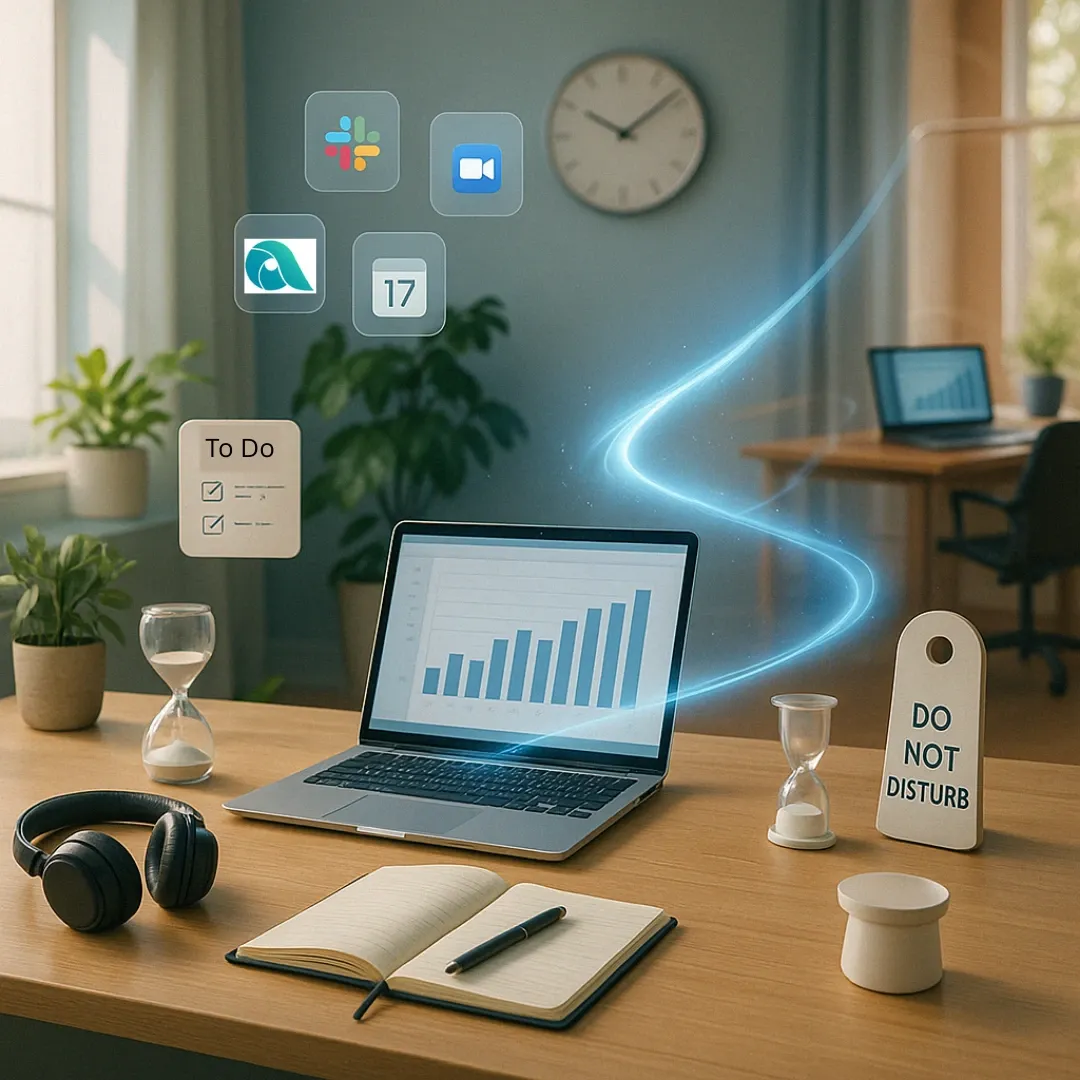
We all know remote and hybrid work offers flexibility.
However, they also bring unique challenges to productivity levels and team efficiency. For example -
- Distraction: The home environment, while comfortable, is often filled with distractions. Family members, pets, household chores, etc., can reduce productive time and employee motivation.
- Isolation: Working alone can lead to feelings of loneliness and disconnection. This often negatively impacts job satisfaction and engagement. You need a traditional office setting for spontaneous interactions, social cues, and team relationships.
- Miscommunication: Digital communication is very convenient. Yet, it can create misinterpretations and misunderstandings. The absence of non-verbal cues and asynchronous digital tools can lead to ambiguity.
So, how to increase efficiency and productivity in the workplace like this? Simply follow these steps -
- Digital Boundaries: Set strict work hours and dedicated spaces. This minimizes interruptions and keeps focus.
- Asynchronous Tools: Use project software for detailed updates, not constant calls. This prevents interruptions and allows for focused work.
- Regular Check-ins: Schedule brief video calls to maintain connection. This fights isolation and keeps everyone aligned.
- Tool Skill: Ensure everyone masters communication tools. This reduces digital friction and improves internal communication.
Manage remote and hybrid teams with Apploye now
What Most People Think What High Workplace Efficiency Looks Like (But Not Actually)
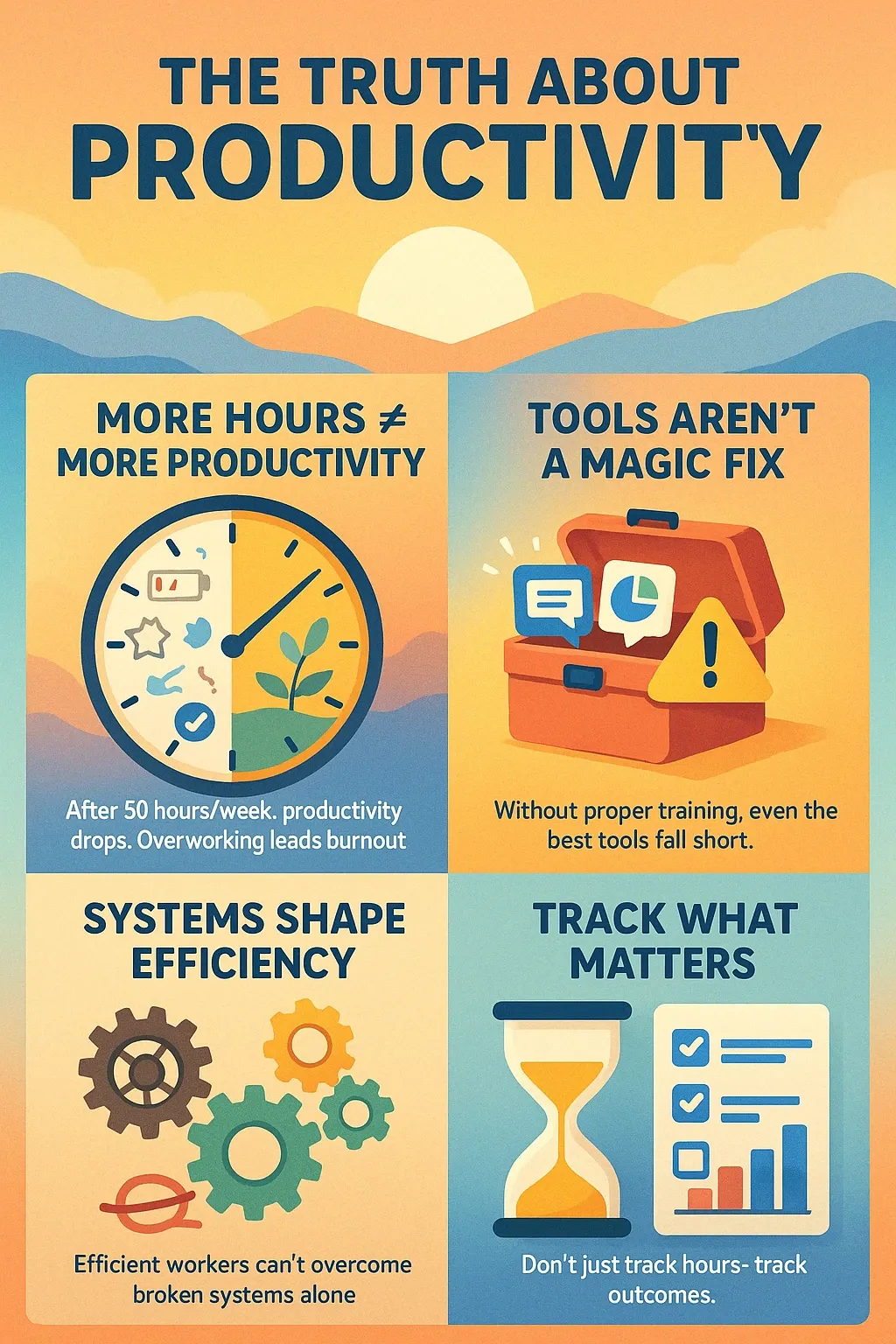
We often chase the idea of "work efficiency" with quick fixes, but many common beliefs are more myth than reality. Let's break them down:
Myth 1: More Hours = More Output
This is a common trap! A study by Stanford University shows productivity falls after 50 hours/week. Working longer often leads to burnout, not better results.
So, overworking can actually be counterproductive!
How to Increase Productivity in a Business
Myth 2: Productivity Tools Solve Everything
Yes, employee productivity tools can help you automate manual tasks. However, productivity tools are useless without employee training!
Think about it: A company buys expensive project management software, but no one learns how to use it. Then it’s a waste of cost savings!
Myth 3: Efficiency is an Individual Trait, Not a Systematic Issue
You can’t be efficient everywhere! Inefficient processes drag down even efficient employees.
A great worker stuck in endless approval chains can face reduced task completion. For example, there may be corruption, office distraction, poor communication, etc.
So, you always need to ensure a workplace efficiency solution first!
Now, you may be thinking that the way forward is monitoring your employees and managing time. However -
Only Time Tracking Isn’t Enough!
Tracking hours worked without measuring actual output or results is like checking your speedometer without knowing where you’re going!
Just logging employee hours doesn't show measurable goals. To understand your operational efficiency, follow the productivity metrics!
How to Calculate Productivity in Business
Let’s boost employee performance the right way
What a Highly Efficient Office Actually Looks Like
Here are some easy steps to improve efficiency at work -
Set SMART goals and clear expectations
The first step is setting SMART goals (Specific, Measurable, Achievable, Relevant, and Time-bound). Make sure to avoid any confusion and have clear expectations.

Alt text: Infographic showing the SMART goal framework: Specific, Measurable, Achievable, Relevant, Time-Bound.
Create a culture of accountability
Performance management thrives on accountability. Discuss missed deadlines constructively, focusing on solutions, not blame. This builds trust and encourages optimal efficiency and team performance!
Offer continuous training and development
Employee training is crucial in today's adaptable workforce. Invest in employee development as much as you can!
Offer opportunities to learn new digital tools and acquire certifications. This will promote both organizational success and employee retention.
Use regular performance reviews
Make performance evaluations an ongoing conversation. Regular feedback helps employees understand their strengths and areas for development.
Use these reviews to set new goals and identify roadblocks to maximum efficiency. You should maintain continuous improvement and enhance employee performance!
Track employee performance with 100% accuracy
See How Managers Sabotage Workplace Efficiency (Unintentionally)
Sometimes, even with the best intentions, managers can create roadblocks to team efficiency. Here's how:
"Checking In" That's Really Micromanaging
Are you constantly asking for updates on every tiny task? This can make employees feel like they're not trusted. So, the autonomy and task completion may slow down.
Meeting Overload
Too many meetings, especially unnecessary ones, eat up valuable productive time. This leaves less time for actual work, impacting productivity levels.
Goals That Are Fuzzy
When goals are vague, employees don't know what to focus on. This leads to confusion, wasted effort, and poor organizational performance.
“The great leaders lead by distilling the why and the what for their teams, peers, and organization, and by overcommunicating to help drive alignment, not through control.”
• Satya Nadella, CEO of Microsoft
These roadblocks can even cause employee turnover. So, focus on fostering trust and transparency in your workplace, not control!
Let’s Measure and Increase Efficiency with Apploye
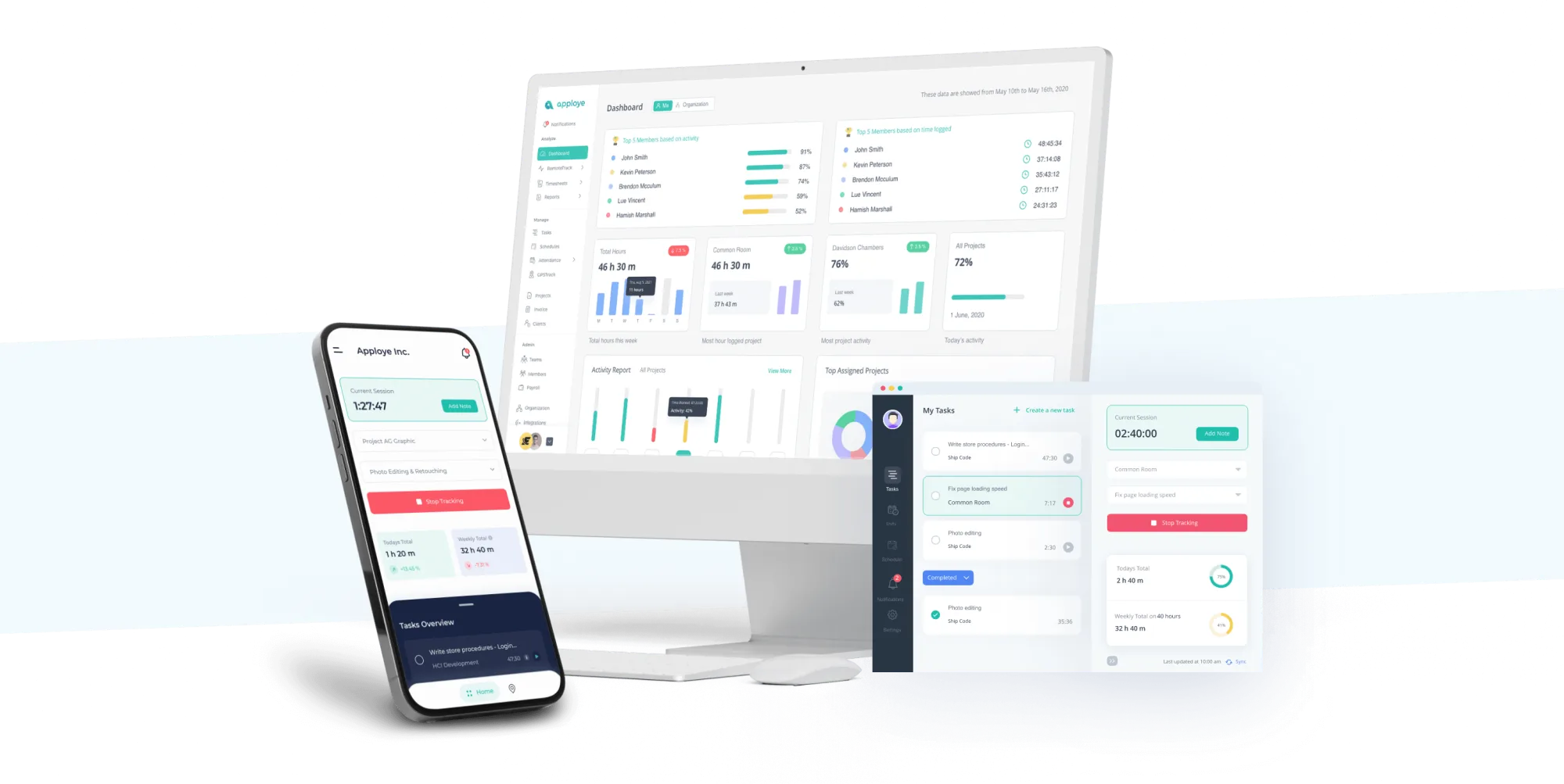
Alt text: A desktop, tablet, and mobile screen displaying a productivity tracking dashboard with analytics.
Want to know if your team is getting more done or just looking busy? Apploye gives you the tools to see real progress -
Key Metrics to Track with Apploye
Track productivity metrics like output per hour and task completion rates. Now, you can get a clear picture of employee performance!
This helps you see where you might have inefficient processes.
Check employee time utilisation to pinpoint areas for efficiency improvement.
Here’s what to do -
- Apploye's dashboards provide real-time insights into your team's productivity levels.
- Use the reports to spot trends and identify bottlenecks.
- Then, make data-driven decisions.
This helps you ensure the most efficiency. You can also track progress toward measurable goals!
Use Apploye to conduct regular, quarterly efficiency audits. This helps you assess your team's organizational efficiency.
How Douglas Academy Improved Productivity by 28% with Apploye
Douglas Academy, a leading Canadian institution for robotics and coding, was trying to keep track of teachers who work at different schools or online.
They also needed to know if everyone was showing up and teaching well.
That’s when Mohammad D., the operations director, decided to try Apploye’s time tracker. Here’s what it did -
- Kept track of work hours automatically: No more guessing when teachers were working.
- Took snapshots of online classes: Just to make sure the teaching was top-notch, without making anyone feel watched.
- Measured how much work was getting done: So they could make sure teachers were being used in the best way.
And guess what? In less than a year, the school got 28% more work done! That's a huge jump.
Monitor all teams effectively with Apploye
Conclusion: Building a Culture of Continuous Improvement
At the end of the day, improving employee efficiency isn’t about working faster. You need to work smarter!
From building a positive workplace culture to using time-tracking tools like Apploye, small steps can lead to big results. Remember, it’s not about pushing harder—it’s about creating the right environment where everyone can thrive.
Efficient teams don’t happen by accident—they’re built with intention, trust, and the right strategies!
Frequently Asked Questions About Improving Employee Efficiency in the Workplace
How can you increase the efficiency of employees at work?
To increase the efficiency of employees at work, set a clear path for your team. Give them goals they understand and the tools they need. Talk to them often and give them feedback so they know how they're doing. And don't forget to celebrate their wins!
Which helps the employee to improve their efficiency?
People work best when they're informed, trained, and feel supported. Give them good tools, arrange flexible hours when possible, and help them learn new skills. A happy, well-equipped employee is a productive employee.
What techniques can you use to improve efficiency?
Use focused work blocks, tackle urgent tasks first, and automate routine jobs. Keep organized with project tools, reduce meeting time, and promote single-task focus.
What are the best ways to increase productivity and efficiency at work?
Start with clear and focused goals! Cut distractions that hinder productivity. Ensure strong, effective communication across the team. Invest in regular training and make data-driven decisions. Build a culture where everyone feels accountable!
What are the best practices to improve efficiency in daily tasks and work processes?
Break big tasks into smaller, easier ones. Use automation for anything that's done over and over. Project management tools are your friend here. Also, keep meetings short and sweet, and encourage people to focus on one task at a time.
What are some ways to improve the health, creativity, and efficiency of a workplace?
Remember, people aren't robots. Encourage them to take breaks and have a good work-life balance. Offer mental health resources and make sure the workspace is comfortable and distraction-free. A happy, healthy team is a creative and efficient team.
What are the impressive techniques to enhance employee performance?
Give regular feedback and provide training for growth. Ensure everyone understands their roles. Celebrate their efforts, allow autonomy, and build a culture of continuous learning.
What are some proven performance improvement strategies that businesses can implement to enhance productivity and efficiency?
For better team performance, set clear, measurable goals. Train your team and review their work. Build a culture of accountability, clear communication, and easy workflow.
What strategies would you use to enhance employee engagement and satisfaction within the workplace?
Build a workplace where everyone feels valued and can grow. Offer flexible work arrangements to support their lives. Encourage open talks, celebrate successes, and create a sense of belonging.
What are the main criteria to maximize the efficiency of a workforce within an organization?
Set clear goals, communicate well, and streamline processes. Give them the right tools, support them as managers, and create a culture where everyone feels responsible.
What are some ways to improve employee health and well-being while improving productivity at work?
Encourage breaks and a healthy work-life balance. Offer mental health support and healthy snacks. Create comfortable workspaces, promote activity, and build a supportive environment.
How do you increase team productivity?
Start with clear goals and improve communication. Use tools that help everyone work together. Foster a positive environment where everyone feels responsible for their part.
What is a good approach to staff motivation and good morale to increase output?
Show your team you value them! Celebrate their wins, help them learn new skills, and make work a good place to be. Encourage open talks, offer flexibility when you can, and build trust. That's how you keep people happy and productive.

